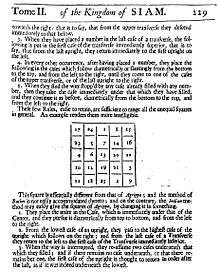Simon de la Loubère
Simon de la Loubère (21 April 1642 – 26 March 1729)[1] was a French diplomat to Siam (Thailand), writer, mathematician and poet. He is credited with bringing back a document which introduced Europe to Indian astronomy, the "Siamese method" of making magic squares, as well as one of the earliest description of parachutes.

Du Royaume de Siam.
Illustration from the English edition (1693).
Mission to Siam
Simon de la Loubère led an embassy to Siam (modern Thailand) in 1687 (the "La Loubère-Céberet mission").[2]:2 The embassy, composed of five warships, arrived in Bangkok in October 1687 and was received by Ok-khun Chamnan. La Loubère returned to France on board the Gaillard on 3 January 1688, accompanied by the Jesuit Guy Tachard, and a Siamese embassy led by Ok-khun Chamnan.[2]:3
Upon his return, La Loubère wrote a description of his travels, as had been requested by Louis XIV, published under the title Du Royaume de Siam: "It was by the orders, which I had the honours to receive from the King upon leaving for my voyage to Siam, that I observed in that country, as exactly as possible, all that appeared to be the most singular.[3]
Loubère also brought back with him an obscure manuscript relating to the astronomical traditions of Siam, which he passed on to the famous French-Italian astronomer Jean Dominique Cassini. The Siamese Manuscript, as it is now called, intrigued Cassini enough so that he spent a couple years deciphering its cryptic contents, determining on the way that the document originated in India.[4] His explication of the manuscript appeared in La Loubere's book on the Kingdom of Siam in 1691,[5]:64–65 which laid the first foundation of European scholarship on Indian astronomy.[6]
French career

La Loubère was elected member of the Académie française (1693–1729), where he received Seat 16, following the 1691 publication of his book Du Royaume de Siam.[2]:59
La Loubère was a friend of the German scientist Gottfried Leibniz, and once wrote that he had "no greater joy than (to discuss) philosophy and mathematics" with him (22 January 1681 correspondence).[3]
Magic square
La Loubère brought to France from his Siamese travels a very simple method for creating n-odd magic squares, known as the "Siamese method" or the "La Loubère method",[7][8][9] which apparently was initially brought from Surat, India, by another Frenchman by the surname of Vincent, who was sailing on the return ship with La Loubère.[5]:238
Siamese parachute
La Loubère is also famous for making one of the earliest account of a parachute following his embassy to Siam. He reported in his 1691 book that a man would jump from a high place with two large umbrellas to entertain the king of Siam, landing into trees, rooftops, and sometimes rivers.[5]:47–48[10]
Works
- Du Royaume de Siam, 1691 Full text in French or English translation
- Traité de l'origine des jeux floraux de Toulouse (1715)
- De la Résolution des équations, ou de l'Extraction de leurs racines, 1732 Full text
See also
- France-Thailand relations
References
- BNF 12101988k
- Tachard, Guy (1999). Smithies, Michael (ed.). A Siamese Embassy Lost in Africa, 1686: The Odyssey of Ok-khun Chamnan. Bangkok: Silkworm Books. ISBN 9747100959. Retrieved 15 October 2017.
- de la Loubere, Simon (2003). Ames, Glenn J; Love, Ronald S (eds.). Distant Lands and Diverse Cultures: The French Experience in Asia, 1600-1700. Westport CT: Praeger. ISBN 0313308640. Retrieved 15 October 2017.
- Burgess, James (1893). "Notes on Hindu Astronomy and the History of Our Knowledge of It". Journal of the Royal Asiatic Society of Great Britain & Ireland: 722–723.
- de La Loubère, Simon (1693). A New Historical Relation of the Kingdom of Siam. Translated by A.P. Retrieved 16 October 2017.
- Hands, Joseph (1879). New Views of Matter, Life, Motion, and Resistance. E.W. Allen. p. 466.
- Eves, Howard W.; Johnson, Phillip E. (1972). Mathematical Circles Squared. Boston: Prindle, Weber & Schmidt. pp. 22. ISBN 0-87150-154-6. OCLC 448077.
- Weisstein, Eric W. (12 December 2002). CRC Concise Encyclopedia of Mathematics. CRC Press. p. 1839. ISBN 978-1-4200-3522-3.
- Pickover, Clifford A. (2002). The Zen of Magic Squares, Circles, and Stars: An Exhibition of Surprising Structures Across Dimensions. Princeton University Press. p. 38. ISBN 978-0-691-07041-4.
- Bull, Stephen (2004). Encyclopedia of Military Technology and Innovation. Greenwood Publishing Group. p. 200. ISBN 978-1-57356-557-8.